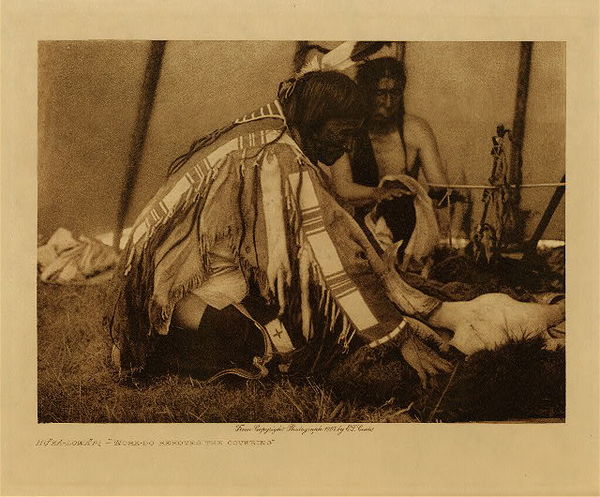Edward S. Curtis (1868-1952)
View Artist Biography
Title:
Huka-Lowapi, "Work-do Removes the Covering" - Sioux
Date:
1907
Size:
Volume, 9.5 x 12.5 inches
Medium:
Vintage Photogravure
This Edward Curtis photograph is depicting a part of a ceremony called Huka-lowapi. The name of the Huka-lowapi ceremony is taken from Huka a term of respect for ones parents or ancestors, and Lowapi, they chant. The purpose of the ceremony is to implant the virtues of kindness, generosity, hospitality, truthfulness, fairness, and honesty. At the same time it is a prayer for continued prosperity, abundance of food, health, strength, and moral well-being as people.
"The name of the Hunká-lowanpi ceremony is derived from hunká, a term of respect for one's parents or ancestors, and lowanpi, they chant. As the Singer becomes the grandfather of the initiate, child or adult, a proper translation of the name seems to be Foster-parent Chant. The principal purpose of Hunká-lowanpi is to implant in the initiate the virtues of kindness, generosity, hospitality, truthfulness, fairness, honesty. At the same time it is a prayer for continued prosperity — for abundance of food, for health, strength, and moral well-being as a people.
"Hunká-lowanpi is usually observed for a child who has been near to death, whose recovery is regarded as the result of the father's solemn promise to worship the Mystery by means of these rites. Having made such a vow, he begins to bend every effort to the accumulation of property— horses, skins, clothing, deerskin bags and parfléches, and many varieties of food. A sufficient quantity collected, he goes to the Hunká-lowankta, the Hunka Singer, and after the usual formal smoke announces his intention, requesting him to take charge of the ceremony.
The Singer, accepting, provides the necessary sacred articles mentioned throughout the description of the rites, and on the day before the ceremony is to occur — it may be months after the intention was proclaimed — he calls to his tipi a certain man, to whom he offers the ceremonial pipe. After the smoke the man is informed that he has been selected as Wówashi-echúnkta, the Work-do, or Worker, which means that he will appear as the principal active participant in the rite. The Singer arrays him in new clothing, and the two sit in the rear of the tipi with the ceremonial paraphernalia tied into a bundle at the Singer's left.
Spreading it between himself and the altar-space, Work-do calls for the buffalo-skull, which the Fire-carrier brings, wrapped in a buffalo-skin given him by the Singer, and lays tenderly on the sage. Work-do as cautiously removes the covering. He now thoroughly works a bit of red paint into a piece of buffalo-tallow, and purifies, first this mixture, then a roll of buffalo hair and a braid of sweet-grass. The hair and the sweet-grass he extends to the buffalo-skull, and after offering them to the spirits of the four quarters feigns to mark a line across its face from left temple to right, just above the orbits." -Edward S. Curtis in "The North American Indian"
The photogravure was taken in 1907 by Edward Curtis and is printed on Dutch Van Gelder. The piece is available for sale in our Aspen Art Gallery.
Provenance: Original Subscription Set #59. George D. Barron, Rye, NY
"The name of the Hunká-lowanpi ceremony is derived from hunká, a term of respect for one's parents or ancestors, and lowanpi, they chant. As the Singer becomes the grandfather of the initiate, child or adult, a proper translation of the name seems to be Foster-parent Chant. The principal purpose of Hunká-lowanpi is to implant in the initiate the virtues of kindness, generosity, hospitality, truthfulness, fairness, honesty. At the same time it is a prayer for continued prosperity — for abundance of food, for health, strength, and moral well-being as a people.
"Hunká-lowanpi is usually observed for a child who has been near to death, whose recovery is regarded as the result of the father's solemn promise to worship the Mystery by means of these rites. Having made such a vow, he begins to bend every effort to the accumulation of property— horses, skins, clothing, deerskin bags and parfléches, and many varieties of food. A sufficient quantity collected, he goes to the Hunká-lowankta, the Hunka Singer, and after the usual formal smoke announces his intention, requesting him to take charge of the ceremony.
The Singer, accepting, provides the necessary sacred articles mentioned throughout the description of the rites, and on the day before the ceremony is to occur — it may be months after the intention was proclaimed — he calls to his tipi a certain man, to whom he offers the ceremonial pipe. After the smoke the man is informed that he has been selected as Wówashi-echúnkta, the Work-do, or Worker, which means that he will appear as the principal active participant in the rite. The Singer arrays him in new clothing, and the two sit in the rear of the tipi with the ceremonial paraphernalia tied into a bundle at the Singer's left.
Spreading it between himself and the altar-space, Work-do calls for the buffalo-skull, which the Fire-carrier brings, wrapped in a buffalo-skin given him by the Singer, and lays tenderly on the sage. Work-do as cautiously removes the covering. He now thoroughly works a bit of red paint into a piece of buffalo-tallow, and purifies, first this mixture, then a roll of buffalo hair and a braid of sweet-grass. The hair and the sweet-grass he extends to the buffalo-skull, and after offering them to the spirits of the four quarters feigns to mark a line across its face from left temple to right, just above the orbits." -Edward S. Curtis in "The North American Indian"
The photogravure was taken in 1907 by Edward Curtis and is printed on Dutch Van Gelder. The piece is available for sale in our Aspen Art Gallery.
Provenance: Original Subscription Set #59. George D. Barron, Rye, NY
